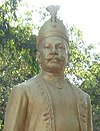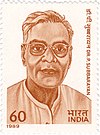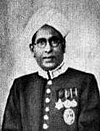Chief Ministers Of Tamil Nadu
Since 1952, Tamil Nadu has had 12 chief ministers, 13 including V. R. Nedunchezhiyan, who twice acted in the role. The longest-serving chief minister, M. Karunanidhi from Dravida Munnetra Kazhagam held the office for over eighteen years in multiple tenures, while he was the one who had the largest gap between two terms (nearly thirteen years). The All India Anna Dravida Munnetra Kazhagam's former general secretary J. Jayalalithaa has the second-longest tenure, and its founder M. G. Ramachandran, the first actor to become the chief minister in India has the third-longest tenure, while his wife V. N. Janaki Ramachandran has the shortest tenure (only 23 days). K. Kamaraj resigned his post of his own free will and devoted all of his energy to the revitalization of the Indian National Congress party; he was responsible for the elevation of Lal Bahadur Shastri to the position of Prime Minister of the Republic of India following the death of Jawaharlal Nehru and of Indira Gandhi following the death of Lal Bahadur Shastri. C. Rajagopalachari served as the last Governor-General of the Union of India before becoming chief minister of undivided Madras State. There have been four instances of president's rule in Tamil Nadu, most recently in 1991.
The current incumbent is M. K. Stalin of the Dravida Munnetra Kazhagam since 7 May 2021.
List of chief ministers
The Madras Presidency, headquartered in Fort St. George, India, was a presidency of India that comprised present day Tamil Nadu, the Malabar region of North Kerala, the coastal and Rayalaseema regions of Andhra Pradesh, and the Bellary, Dakshina Kannada, and Udupi districts of Karnataka. It was established in 1653 to be the headquarters of the English settlements on the Coromandel Coast.
The territory under the presidency comprised only Madrasapattinam and its surrounding regions. But, after the Anglo-French wars and the consequent alliance between the English East India Company and the Nawab of Arcot, it was expanded to comprise the region from the Northern Circars to Cape Comorin. The governance structure also evolved from a modest secretariat with a single secretary for the Public Department in 1670 to six departments overseen by a chief secretary by 1920.
The Indian Councils Act 1861 set up the Madras Legislative Council as an advisory body, without powers, through which the colonial administration obtained advice and assistance from able and willing Indian business leaders. But membership was selected (not elected) and was not representative of the masses.
With the enactment of the Government of India Act 1919, the first legislature was formed in 1920 after general elections. The term of the legislative council was three years. It had 132 members, of whom 34 were nominated by the governor and the rest were elected. Under the Government of India Act 1935, a bicameral legislature was set up with a legislative assembly consisting of 215 members and a legislative council having 56 members. The first legislative assembly under this act was constituted in July 1937. The legislative council was a permanent body, with a third of its members retiring every 3 years and having the power to decide on bills passed by the assembly.
In 1939, the Governor-General of India declared India's entry into World War II without consulting the Imperial Legislative Council. The Indian National Congress protested by asking all its elected representatives to resign from governments. Then it came back to power in 1946 after new provincial elections.


























